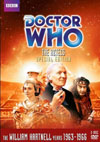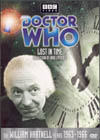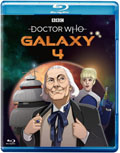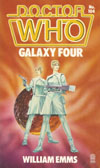Galaxy Four
|
(Doctor Who Story No. 18, starring William Hartnell)
- written by William Emms
- directed by Derek Martinus
- produced by Verity Lambert
- featuring library music tracks
- 4 episodes @ 25 minutes each:
| 1. |
| Four Hundred Dawns |
| 2. |
| Trap of Steel |
| 3. |
| Air Lock |
| 4. |
| The Exploding Planet |
|
Story: Materializing on a desolate alien planet,
the Doctor, Steven, and Vicki are soon rescued from
enigmatic robots by a race of young female soldiers
called Drahvins. The Drahvins have been in a fight for
survival against the hideous Rills and their "Chumbley" machines
ever since each side crashed here, and the Drahvins
are desperate to find a way off the planet before its
decaying orbital conditions cause it to explode. Will the
Doctor and his friends be able to help the Drahvins without
getting caught in the cross-fire? How much are the Drahvins
willing to say about what the Rills are really after?
|
|
Blu-ray / DVD Features include:
- One digitally remastered complete original episode (#3), plus surviving clip from episode 1
- New animated recreations of all four episodes,
synchronized to the original television sound. (Colour & BW options)
- Photographic Reconstructions of episodes 1, 2, and 4
- Plus extra features, with Peter Purves (Steven) and Maureen O'Brien (Vicki):
- Audio commentaries
- Making-Of Documentary
- "Finding Galaxy 4" documentary
- Photo Gallery
- Pop-up Production Note Subtitles
- DVD-Rom PDF Material
|
In March 2013, a substantial amount of video material from this story
was released on
"The Aztecs" - Special Edition
DVD, which
included the newly rediscovered episode three - "Air Lock",
and both the 5-minute and 10-second clips from episode one,
all presented as part of a 64-minute recreation of the entire story.
The recreation is composed mostly of a montage of telesnap and
still frames accompanying the original television soundtrack,
but it also features many shots of the Chumbley machines achieved with
very satisfying full-motion 3D CGI models.
More details & buying options for "The Aztecs" Special Edition DVD's
|

|
In-Depth Analysis Review
by Martin Izsak
|
|
WARNING: This review contains "SPOILERS", and is intended for
those who have already seen the program. To avoid the spoilers,
read the Buyers' Guide version instead.
|
As written, this is a very excellent and exceptional story,
having all the elements I like to see in a Doctor Who adventure.
Its production is a good distance from being perfect, but all
things considered, season three can boast opening with a decent
sci-fi story that is more interesting, serious, and climactic than
anything season two put out. Verity Lambert's last real story as
producer is something of a triumph.
The distinctive library music tracks build a light
but nevertheless alien atmosphere for the lonely dying planet
on which this adventure takes place. The music is okay
for the most part, successfully alien and even brilliant in
some places, and generally works. Knowing these particular tracks
as well as I do, I don't think the production team always managed to find the
most appropriate sections to back every scene, often selecting bits
that were too serene instead of some of the more suspenseful
or action oriented sections that were available, but this
doesn't detract much from the story.
The TARDIS seems to have made a good materialization on the original
television broadcast. Although the novelization unfortunately skips
over it, the new recreation on DVD nicely indulges us with it again.
The rest of the essential features of the TARDIS
and those of the main characters are well demonstrated
in the opening sequence, as they encounter their first Chumbley
robot, and both parties become curious and investigate each other
from either side of the TARDIS interior/exterior barrier. One
couldn't ask for anything better in theory, although the recreation
is limited in being able to showcase the interior space. Fear of the unknown
has no power to stop the three regular characters from exploring outside
the ship and beyond as well, as they eagerly jump into danger
and first contact situations. They'll also tackle heroics
in satisfying fashion before they're
finished with this place. All the right stuff, in the right
order, starting the season off to boot.
The appearance stereotypes of sci-fi good guys and bad guys
are neatly swapped, of course, and this forms the major theme of
the story:
"What difference does it make what your form is?"
"The importance lies in the character....."
This works as an objective observation, but subjectively
are all the right things demonstrated by dialogue and performances?
In this area, the novel is more polished than the televised
version. It takes a bit of time for our travellers to sort out
who's who in the novel, but it still happens fairly quickly:
Half way through
the first episode, they know quite well that they don't like the
dolled-up Drahvins. On television, it appears to happen even
faster, dangerously fast in fact. Not only do the Doctor and Vicki
notice the Drahvins' bad qualities early, they seem to realize it
before even getting to know them (their tone of voice gives that
away)..... Knowing enough not to judge a book by its cover,
the Doctor and Vicki settle for the alternative of judging
this book by its last page instead, not giving the Drahvins
as fair a chance as good first contact etiquette would
dictate. Part of this is the script's fault, but writer William
Emms, to his credit, did a good job of fixing this in his novel,
removing most of the give-away dialogue, and re-inserting the gist
of it later when the time for judgment is more ripe, and when the
main characters can put it to a less confrontational use by
thinking it or discussing it amongst themselves. The altered timing
on 2013's DVD recreation might have allowed it to tighten up this
aspect and bring it closer in line with the novel, but this doesn't
really happen. The version on DVD is about the same as that of
the full CD audio in offering corrected judgments a little too quickly
and harshly.
Advice on how
not to judge someone, like all advice on what not to do, pales
in comparison to advice on what to do:
Seek first to understand.
This the book achieves much better than the TV story. Unfortunately,
the Doctor's pointless fib over the timing of the catastrophe is
left as is, a black mark against his character in both versions
which can do absolutely zero to help his situation. The other half
of the blame in not giving the Drahvins a fair chance must go to
the cast, who quite possibly over-rehearsed the story until they
forgot that they're not supposed to know how bad the Drahvins are
at first. Hostility enters their voices a little too easily in
many cases. William Hartnell has had better scenes of introduction
to guest characters, but he doesn't do too badly here, and still
manages some choice lines with excellent delivery.
Judging by sound alone, the Drahvins themselves seem to act a little
stiffly, which is not altogether out of character for them.
The existing 5-minute film clip reveals additional visual nuances
that make the performances significantly more believable.
However, they are meant to be emotional beings,
and the fear and loathing of the Rills that motivates them
throughout the story is still not quite all that it should
be. That said, getting a complete episode plus many stills from
the other episodes unveils much of what wasn't conveyed by voice alone,
and the Drahvins actually become much more believable.
Stephanie Bidmead, playing the Drahvin leader Maaga, puts in a very
compelling performance that outclasses many of the "strong" women
seen in later years of the show, including New Millennium Who,
and that performance is chiefly responsible for selling many of the story's
more bone-chilling moments. Good stuff.
Musically, the Drahvins are sometimes accompanied by a swinging, blues
clarinet sound out of the 1920's, 30's or 40's. This is kind of
weird, as it doesn't fit well with their characters, but with visuals,
it can work as a counterpoint. Something
a little more sinister would be more in line with them. (Now, if
Brian Hodgson had slowed that clarinet down and processed it....)
Robert Cartland's performance of the Rill voice sounds a bit
on the pompous, high-and-mighty side, and doesn't convey the Rill
tranquility so carefully mapped out in the novelization. The
regulars and the Rills end up a bit on the
smug-and-pleased-with-themselves side of things when all is said
and done. However,
content matters more than style, especially with a story poised
to make that very point, and the Rills' words and actions speak
louder than their hasty, makeshift vocal qualities. Getting over
their voice is another of the ethical challenges presented.
The Drahvins deserve little sympathy from our regular
characters from episode one onwards, but what really sustains
"Galaxy Four" is that regulars and Drahvins alike continue to fear
the Rills even more up until the middle of episode three. This is
largely because they don't see them at all, and their robotic
"Chumbley" servants are very enigmatic alien caricatures, unable
to communicate effectively during this time, and resembling the
very untrustworthy Daleks to boot. The sounds you will almost
certainly remember long after hearing this story are those of the
Chumbleys. Brian Hodgson has assembled one of his most effective
montages to date, successfully bringing to life these creations,
alien yet neutral, mysterious and sinister while remaining unknown,
yet containing a cute pattern and orderly beauty. Once the
communication barrier is broken, the Rills' good nature is plain for
everyone to see. Even with additional revelations about the first
encounter between these two alien specie from the Rills' point of
view left for the major turning point later in the adventure, the
characters are allowed to present themselves true to form throughout
the story, no elaborate manoeuvres required, and there is much
gripping conflict all the way through for all concerned. Thus it
seems to be much better written than similar ideas inherent in
"The Rescue" (story no. 11) and
"The Sensorites" (story no. 7),
and drives the point home better.
Galaxy Four generally has better written action as well,
and the Doctor's your man in this one as the central, heroic
character. Steven's contributions in helping to disable
a Chumbley by the pit (novel only) and in matching Maaga toe to
toe on a physical level should be noted, as should Vicki's initial
first contact negotiations with the Rills. The Doctor is
much more of the habitual, reasonable, lead problem-solver
in this one though, and it's a vast improvement over his
usual season two antics. His heroic contribution to the
story's resolution continues slow but steady all throughout
the final episode, while also leaving a lot of time for
diplomatic niceties to be exchanged, and a high-tech sci-fi
guerrilla battle to ensue on the planet's surface, keeping
the level of drama high, interesting and logical all throughout
as the episode builds to a satisfying climax.
Sadly, not everything is improved by having new visuals of the
story. The biggest letdown by far is the design of the Rill spacecraft,
which suggests at every turn that the budget for year 2's recording block
had run out. It ends up looking like some kind of greenhouse with absolutely no
ability to be airtight - while the script absolutely demands that it maintain
different atmospheres in different compartments. The biggest design mistake
here is definitely the transparent nature of most walls,
which destroys the viewers' ability to imagine that far more technical
wizardry and undiscovered sections might be hiding behind them. We could
excuse a small set inside a large spacecraft, but transparent walls
suggest the craft's exterior is really too small as well. The Doctor's dialogue
works against this bizarrely, as he continually praises the Rills' advanced
spacecraft design. Thankfully though,
the Rills themselves work well, and we somehow only manage to see
as much of them at any time as the script intends.
I had half-expected some 3D CGI-shots of launching spacecraft and an exploding
planet, but such avenues were not pursued in the recreation. The final battles
are also somewhat limited. The Drahvins' weapons, while making a cameo in
"Genesis of the Daleks" some ten years later,
operate on flash-charges which is about as good as you get on Doctor Who
before superimposed lasers started much later. The Chumbleys get little
puffs of steam for their weapons, which seems less advanced, but this effect
does at least get a more impressive debut in part one.
Sound effects for laser blasts are particularly lame this
time around, a quiet and dull bit of white noise that is
practically inaudible whenever something else is going on.
Improvement here could have lifted the excitement level of
the drama's conclusion considerably.
In terms of new visuals, what really impresses most is some of the creative
work of director Derek Martinus, both in getting really enjoyable
performances out of all the actors, and in often showing action that
was in no way suggested by the sound alone. And of course, CGI Chumbleys
allow a lot of their action to be on screen, and possibly more effective
and glitch-free than had been the case in the original footage. In cases
where action could not be visually recreated, we get subtitles explaining
it for us, as had been done with the 2000 A.D. VHS recreation of
"The Tenth Planet" (story no. 29), as opposed
to the less enjoyable narration in the VHS abridgement for
"The Ice Warriors" (story no. 39).
The final moments of
"Galaxy Four" still work quite well, and the story could end on a
high note there. Unfortunately, we also get a prologue to the
prologue for
"The Dalek Masterplan" (story no. 21),
an uninspiring scene of
a delirious man in a jungle consumed with murderous thoughts. This
is not at all suspenseful, particularly as no confrontation can
be anticipated between him and the regular characters,
(not to mention the fact that, with the Doctor having just
complained that this sort of unrest happens all the time,
it all seems so routine for this show), and the
poor scene merely detracts from the moral point of "Galaxy Four".
It might have been better to video-tape the regulars' comments
as the introduction to next week's episode, and not have anything
of the jungle of Kembel as a part of this story at all.
The presentation on the 2013 DVD also leaves something to be desired
in lumping the whole story together as a single menu item of 64 minutes
41 seconds duration. Thankfully, it is split up with 16 chapter points, in which
episode three can be seen complete with its own individual titles and credits
in chapters 7 - 12. No division between episodes one and two can be easily
identified here, but then episode one never did have a great cliffhanger
anyway. Episodes two and three have much stronger cliffhangers, which
are easy to enjoy in this DVD version.
All things considered, "Galaxy Four" is a top notch season
three story, and a great example of the Hartnell era at its best.
I'm still secretly hoping that more of this one gets rediscovered on film
earlier than many other missing Hartnell episodes. Had this story been a
part of season two, it would have easily have come out on top
as the best story, no contest. However, as a part of
the more turbulent season three,
there are a number of other excellent stories ready to give it
a good run for its money.....
International Titles:
Deutsch: (Galaxis Vier)
Magyar: "A négyes galaxis"
- 400 hajnal
- Acélcsapda
- Zsilip
- A robbanó bolygó
Русский: "Галактика 4"
- Четыреста рассветов
- Стальная ловушка
- Воздушный шлюз
- Взрывающаяся планета
Italiano:
- Quattrocento albe
- Trappola d'acciaio
- Tenuta stagna
- Il pianeta che esplode
Français: (La Galaxie 4)
Episode Three's title "Air Lock" seems to get a somewhat loose translation
in some of these languages, where it is not readily apparent that
a part of a spacecraft is being referred to.
Well, the Russians put the first man in space,
so they seem to get it best: "Air Lock", full marks.
Galaxy Four
(starring William Hartnell)
This story is not known to exist in its original format
(4 black-and-white 25-minute TV episodes) in its entirety.
A new full-length animated version has now been bundled with
the previous photo reconstruction version that incorporated all known surviving footage:
Blu-ray / DVD Features include:
- One digitally remastered complete original episode (#3), plus surviving clip from episode 1
- New animated recreations of all four episodes,
synchronized to the original television sound. (Colour & BW options)
- Photographic Reconstructions of episodes 1, 2, and 4
- Plus extra features, see top of page for full list.

|
Doctor Who: "The Aztecs" Special Edition
2 DVD discs
NEW for 2013 March
|
Coverage on Galaxy Four includes:
- An abridged recreation of episodes 1 and 2 (28 min.)
featuring telesnap and video stills accompanied by the original TV soundtrack,
plus numerous new 3D CGI shots of the Chumbley machines.
This also includes:
- 8mm off-screen clip from Episode 1 with full sound
(TARDIS interior, approx. 10 seconds)
- 5 minute original full-motion clip from Episode 1 (Four Hundred Dawns)
as the Doctor & crew discover the Drahvin
spacecraft & meet Maaga.
- Episode 3: "Air Lock" (24 min. 19 sec.)
- A 12-minute recreation of episode 4, in the same style as that for episodes 1 & 2.
More details & buying options for "The Aztecs" Special Edition DVD's
|
This makes the previously available sources of video material
from this story less important:
 |
Doctor Who: Lost in Time - Patrick Troughton
2 DVD discs
(also included in Lost in Time Boxed Sets) |
Coverage on Galaxy Four includes:
- 5 minute clip from Episode 1 (Four Hundred Dawns)
as the Doctor & crew discover the Drahvin
spacecraft & meet Maaga.
This full clip can be found as part of
"The Missing Years" documentary, on the
second Patrick Troughton disc.
More details & buying options for "Lost in Time" DVD's
 |
Doctor Who: Lost in Time - William Hartnell
1 DVD disc
(also included in Lost in Time Boxed Sets) |
Coverage on Galaxy Four includes:
- 8mm off-screen clip from Episode 1 with full sound
(TARDIS interior, approx. 10 seconds)
More details & buying options for "Lost in Time" DVD's
This 2 CD set features the complete audio tracks
of all 4 television episodes of this story:
- The CD Audio version features narration by
actor Peter Purves (who also played Steven Taylor)
to help listeners follow what used to be visual aspects
of the story. This version spans both discs
and is playable in any normal audio CD player.
Comments on this article are welcome. You may contact
the author from this page:
Contact page
|














 (hardcover)
(hardcover)



